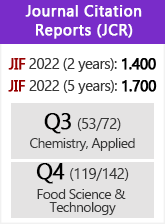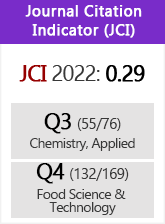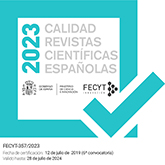Shelf-life of Moroccan prickly pear (Opuntia ficus-indica) and argan (Argania spinosa) oils: a comparative study
DOI:
https://doi.org/10.3989/gya.1147192Keywords:
Cosmetics, Oil preservation, Oxidative stabilityAbstract
Cactus seed oil is gaining considerable popularity in the cosmetic industry. To estimate cactus seed oil’ industrial as well as domestic ease of use, we investigated the oxidative stability of Moroccan cactus seed oil under accelerated aging conditions. In addition, we compared cactus seed oil stability to that of argan oil, a popular and well-established cosmetic oil, under the same conditions. Cactus seed oil is much more sensitive to oxidation than argan oil. Its shelf-life can be estimated to be no longer than 6 months at room temperature. Such instability means that the preparation process for cactus oil must be carried out with great care and cactus seed oil needs to be protected once extracted.
Downloads
References
AOCS Official Method Ce 8e89. 1983. In American Oil Chemist's Society, Determination of tocopherols and tocotrienols in vegetable oils and fats by HPLC. Uniform Methods Committee. Champaign, Il, AOCS. Charrouf Z, Guillaume D. 1999.
Ethnoeconomical, ethnomedical, and phytochemical study of Argania spinosa (L.) Skeels. J. Ethnopharmacol. 67, 7-14. https://doi.org/10.1016/S0378-8741(98)00228-1
Charrouf Z, Guillaume D. 2008. Argan oil: Occurrence, composition and impact on human health. Eur. J. Lipid Sci. Technol. 110, 632-636. https://doi.org/10.1002/ejlt.200700220
Charrouf Z, Guillaume D. 2014. Argan oil, the 35‐years‐of‐research product. Eur. J. Lipid Sci. Technol. 116, 1316-1321. https://doi.org/10.1002/ejlt.201400261
Charrouf Z, Guillaume D, Driouich A. 2002. The argan tree, an asset for Morocco. Biofutur. 220, 54-56.
Charrouf Z, Guillaume D. 2018. The argan oil project: going from utopia to reality in 20 years. Oilseeds & Fats, Crops and Lipids 25, D209. https://doi.org/10.1051/ocl/2018006
Ciriminna R, Bongiorno D, Scurria A, Danzì C, Timpanaro G, Delisi R, Avellone G, Pagliaro M. 2017. Sicilian Opuntia ficus-indica seed oil: Fatty acid composition and bio-economical aspects. Eur. J. Lipid. Sci. Technol. 119 (11), 1700232. https://doi.org/10.1002/ejlt.201700232
Commission Regulation (EEC) (2568/91) 1991. Official Journal of the European Community, L 248, 1.
Coskuner Y, Tekin A. 2003. Monitoring of seed composition of prickly pear (Opuntia ficusindica L.) fruits during maturation period. J. Sci. Food Agric. 83, 846-849. https://doi.org/10.1002/jsfa.1423
El Finti A, El Boullani R, Fallah M, Msanda F, El Mousadik A. 2013. Assessment of some agrotechnological parameters of cactus pear fruit (Opuntia ficus-indica Mill.) in Morocco cultivars. J. Med. Plants Res. 7, 2574-2583 https://doi.org/10.17660/ActaHortic.2013.995.6
El Mannoubi I, Barrek S, Skanji T, Casabianca H, Zarrouk H. 2009. Characterization of Opuntia ficus-indica seed oil from Tunisia. Chem. Nat. Comp. 45, 616-620. https://doi.org/10.1007/s10600-009-9448-1
Feugang JM, Konarski P, Zou D, Stintzing FC, Zou C. 2006. Nutritional and medicinal use of Cactus pear (Opuntia spp.) cladodes and fruits. Front Biosci. 11, 2574-2589. https://doi.org/10.2741/1992 PMid:16720335
Gharby S, Harhar H, El Monfalouti H, Kartah B, Maata N, Guillaume D, Charrouf Z. 2012a. Chemical and oxidative properties of olive and argan oils sold on the Moroccan market. A comparative study. Med. J. Nutr. Metab. 5, 31-38. https://doi.org/10.1007/s12349-011-0076-5
Gharby S, Harhar H, Guillaume D, Haddad A, Matthäus B, Charrouf Z. 2011. Oxidative stability of edible argan oil: A two-year study. LWT-Food Sci. Technol. 44, 1-8. https://doi.org/10.1016/j.lwt.2010.07.003
Gharby S, Harhar H, Guillaume D, Haddad A, Charrouf Z. 2012b. The origin of virgin argan oil's high oxidative stability unraveled. Nat. Prod. Commun. 7, 621-624. https://doi.org/10.1177/1934578X1200700520
Gharby S, Harhar H, Kartah B, Guillaume D, Chafchaouni I, Charrouf Z. 2014. Oxidative stability of cosmetic argan oil: a one-year study. J. Cosmetic Sci. 65, 81-87
Guillaume D, Charrouf Z. 2011. Argan oil and other argan products: Use in dermocosmetology. Eur. J. Lipid Sci. Technol. 113, 403-408. https://doi.org/10.1002/ejlt.201000417
Guillaume D, Charrouf Z. 2013. Argan oil for nutritional and skin care applications. HPC Today 8, 28-30.
Guillaume D, Gharby S, Harhar H, Baba M. 2015. Opuntia ficus-indica and Balanites aegytiaca oils: two seed oils to watch. HPC Today 10, 45-48.
Harhar H, Gharby S, Guillaume D, Charrouf Z. 2010. Effect of argan kernel storage conditions on argan oil quality. Eur. J. Lipid Sci. Technol. 112, 915-920. https://doi.org/10.1002/ejlt.200900269
Labuschagne MT, Hugo A. 2010. Oil content and fatty acid composition of cactus pear seed compared with cotton and grape seed. J. Food Biochem. 34, 93-100. https://doi.org/10.1111/j.1745-4514.2009.00266.x
Matthäus B, Guillaume D, Gharby S, Haddad A, Harhar H, Charrouf Z. 2010. Effect of processing on the quality of edible argan oil. Food Chem. 120, 426-432. https://doi.org/10.1016/j.foodchem.2009.10.023
Matthäus B, Özcan MM. 2011. Habitat effects on yield, fatty acid composition and tocopherol contents of prickly pear (Opuntia ficus-indica L.) seed oils. Scientia Hort. 131, 95-98. https://doi.org/10.1016/j.scienta.2011.09.027
Monia E, Bourret E, Mondolot L, Attia H. 2005. Fatty acid composition and rheological behaviour of prickly pear seed oils. Food Chem. 93, 431-437. https://doi.org/10.1016/j.foodchem.2004.10.020
Özcan MM, Al Juhaimi FY. 2011. Nutritive value and chemical composition of prickly pear seeds (Opuntia ficus-indica L.) growing in Turkey. Internat. J. Food Sci. Nutr. 62, 533-536. https://doi.org/10.3109/09637486.2011.552569 PMid:21391790
Piga A, 2004. Cactus pear: a fruit of nutraceutical and functional importance. J. Prof. Assoc. Cactus Dev. 6, 9-22.
Ramadan MF, Mörsel JT. 2003. Oil cactus pear (Opuntia ficus-indica L.). Food Chem. 82, 339-345. https://doi.org/10.1016/S0308-8146(02)00550-2
Salvo F, Galati EM, Lo Curto S, Tripodo MM. 2002. Study on the chemical characterization of lipid composition of Opuntia ficus-indica L. seed oil. Riv. Ital. Sost. Grasse 79, 395-398. https://doi.org/10.17660/ActaHortic.2002.581.33
Sawaya WN, Khan P. 1982. Chemical characterization of prickly pear seed oil, Opuntia ficus‐ indica. J. Food Sci. 47, 2060-2061. https://doi.org/10.1111/j.1365-2621.1982.tb12946.x
Stewart RRC, Bewley JD. 1980. Lipid peroxidation associated with accelerated Aging of soybean axes. Plant Physiol. 65, 245-248. https://doi.org/10.1104/pp.65.2.245 PMid:16661168 PMCid:PMC440305
Taoufik F, Zine S, El Hadek M, Idrissi Hassani LM, Gharby S, Harhar H, Matthäus B. 2015. Oil content and main constituents of cactus seed oils Opuntia Ficus-indica of different origin in Morocco. Med. J. Nutr. Metab. 8, 85-92. https://doi.org/10.3233/MNM-150036
Waal HO de, Louhaichi M, Taguchi M, Fouché HJ, De Wit M. 2015. Development of a cactus pear agro-industry for the sub-Sahara Africa Region. Proceedings of International Workshop, University of the Free State, Bloemfontein, South Africa, 96 pp.
Wit M de, Hugo A, Shongwe N. 2016. Quality assessment of seed oil from selected cactus pear cultivars (Opuntia ficus-indica and Opuntia robusta). J. Food Process. Preserv. 41, e12898. https://doi.org/10.1111/jfpp.12898
Zaanoun I, Gharby S, Bakass I, Ait addi E, Ait ichou I. 2014. Kinetic parameter determination of roasted and unroasted argan oil oxidation under Rancimat test conditions. Grasas Aceites 65 (3), e033. https://doi.org/10.3989/gya.122713
Zine S, Gharby S, El Hadek M. 2013. Physicochemical characterization of Opuntia ficus-indica Seed Oil from Morocco. Biosci. Biotech. Res. Asia, 10, 99-105. https://doi.org/10.13005/bbra/1099
Published
How to Cite
Issue
Section
License
Copyright (c) 2021 Consejo Superior de Investigaciones Científicas (CSIC)

This work is licensed under a Creative Commons Attribution 4.0 International License.
© CSIC. Manuscripts published in both the printed and online versions of this Journal are the property of Consejo Superior de Investigaciones Científicas, and quoting this source is a requirement for any partial or full reproduction.All contents of this electronic edition, except where otherwise noted, are distributed under a “Creative Commons Attribution 4.0 International” (CC BY 4.0) License. You may read here the basic information and the legal text of the license. The indication of the CC BY 4.0 License must be expressly stated in this way when necessary.
Self-archiving in repositories, personal webpages or similar, of any version other than the published by the Editor, is not allowed.
















